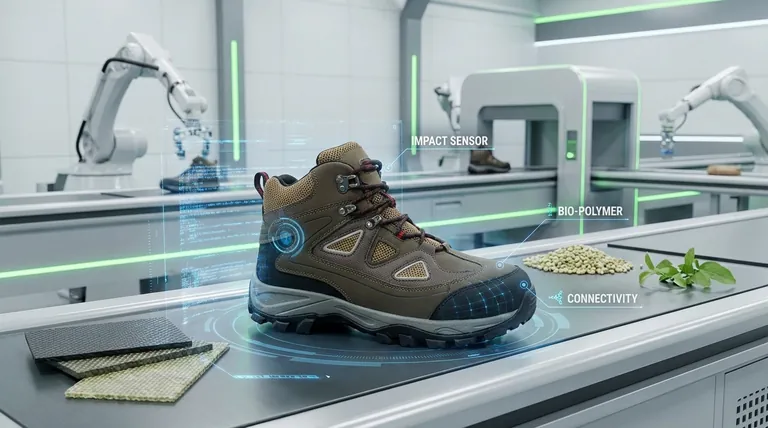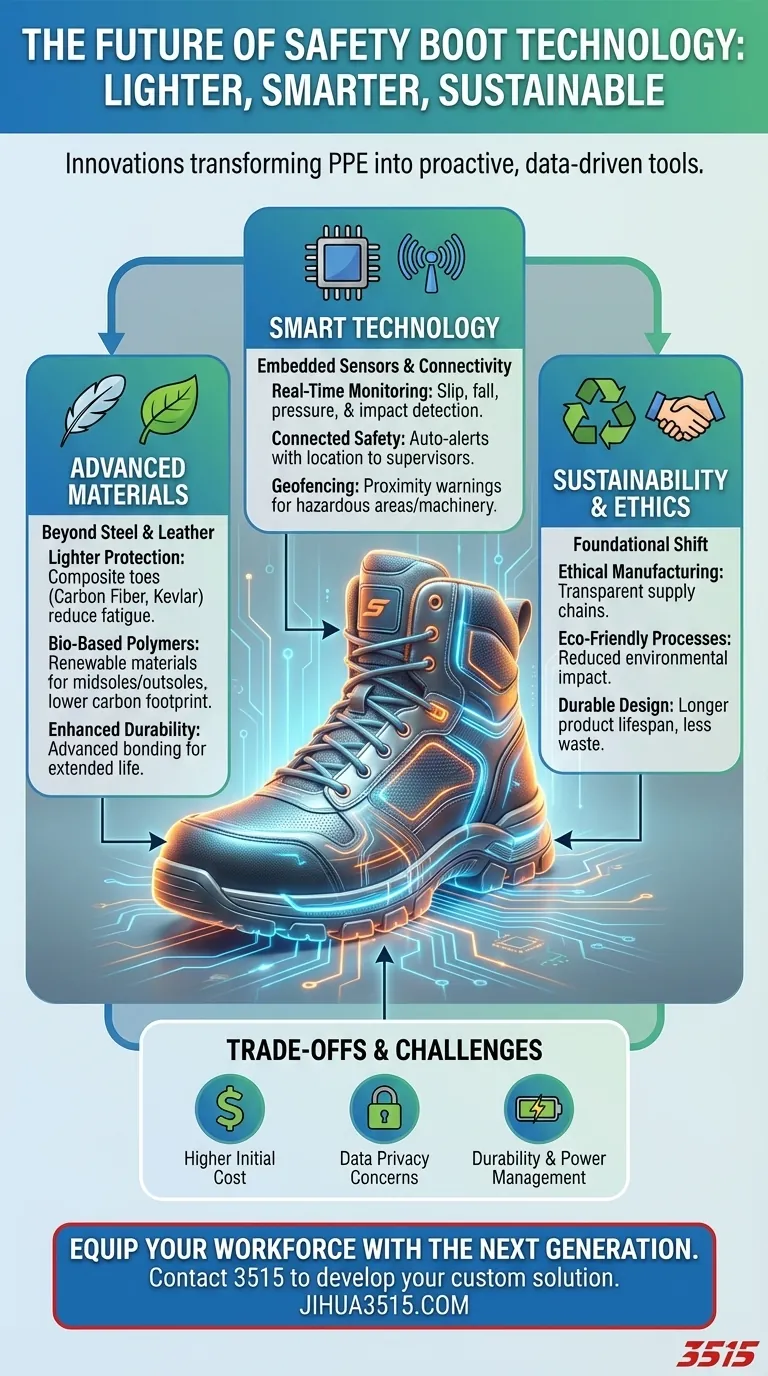The future of safety boot technology is moving beyond simple passive protection and into an era of lighter, smarter, and more sustainable design. Key innovations revolve around three core areas: advanced materials like composites and bio-polymers, the integration of smart technology for real-time monitoring, and a foundational shift toward sustainable and ethical manufacturing.
The next generation of safety footwear is being redefined from a simple piece of personal protective equipment (PPE) into an active, data-driven tool that enhances worker safety, reduces fatigue, and aligns with corporate environmental goals.

The Evolution of Materials: Beyond Steel and Leather
The traditional steel-toed boot is undergoing a significant material science upgrade. The goal is to provide equal or greater protection with a substantial reduction in weight, directly impacting worker fatigue and comfort over a long shift.
Advanced Composites for Lighter Protection
New safety toes and puncture-resistant plates are increasingly made from composite materials like carbon fiber, Kevlar, or specialized fiberglass. These materials can meet or exceed ASTM and EN safety standards for impact and compression resistance while being significantly lighter than their steel counterparts.
This weight reduction is a critical factor in minimizing the musculoskeletal strain that workers experience from lifting their feet thousands of times per day.
The Rise of Bio-Based Polymers
The industry is actively seeking alternatives to petroleum-based plastics and rubbers used in midsoles and outsoles. Bio-based polymers, derived from renewable sources like corn or sugarcane, are emerging as a viable, more sustainable option.
These materials are being engineered to offer the same durability, slip resistance, and cushioning properties as traditional materials, but with a much lower carbon footprint.
A Focus on Enhanced Durability
Innovations also target the overall lifespan of the boot. Manufacturers are exploring advanced bonding techniques and more resilient upper materials that resist abrasion, chemical breakdown, and water intrusion more effectively, extending the footwear's usable life.
The Integration of Smart Technology
The most transformative trend is embedding electronics directly into the boot, turning it into a connected device that provides real-time safety insights. This shifts the function of footwear from preventing injury to proactively predicting and reporting risk.
Embedded Sensors for Real-Time Monitoring
Miniaturized sensors can now be integrated into the sole of the boot to detect a wide range of events. These can include accelerometers to detect slips and falls, pressure sensors to analyze posture and fatigue, and impact sensors to report when a heavy object has fallen on the foot.
Connected Safety Systems
These "smart boots" are designed to communicate with a central system or a worker's mobile device via Bluetooth or other low-power wireless protocols. If a fall is detected, the boot can automatically send an alert to a supervisor with the worker's precise location.
Geofencing and Proximity Alerts
In complex industrial environments, boots can be programmed with geofencing capabilities. They can alert a worker if they are about to enter a restricted or hazardous area, or warn them of the proximity of heavy machinery like forklifts.
Understanding the Trade-offs and Challenges
While these innovations offer significant advantages, it's crucial to approach them with a clear understanding of their current limitations and implications.
The Cost Factor
Advanced materials and embedded electronics come at a higher initial purchase price than traditional safety boots. The long-term value must be calculated based on potential reductions in workplace injuries and improved worker productivity.
Data Privacy and Security
The collection of worker data, even for safety purposes, raises important privacy concerns. Companies must have transparent policies about what data is collected and how it is used, along with robust cybersecurity measures to protect that information.
Durability and Power Management
Electronics in a harsh industrial environment face significant challenges, from water and chemical exposure to repeated impacts. Furthermore, battery life and the logistics of keeping a fleet of boots charged are practical hurdles that must be addressed in any deployment plan.
Making the Right Choice for Your Goal
Adopting these new technologies should be driven by your organization's specific safety and operational priorities.
- If your primary focus is reducing worker fatigue and musculoskeletal strain: Look for boots built with advanced composite safety toes and lighter-weight polymer soles.
- If your primary focus is proactive incident prevention and lone worker safety: Prioritize investment in smart boots with fall detection and connected alert systems.
- If your primary focus is aligning with corporate sustainability goals: Seek out manufacturers who are transparent about their use of bio-based materials, green manufacturing processes, and ethical supply chains.
Ultimately, the evolution of safety footwear is about treating the worker as a whole, creating a system that protects them more intelligently and sustainably than ever before.
Summary Table:
| Trend Category | Key Innovations | Primary Benefit |
|---|---|---|
| Advanced Materials | Composite toes (carbon fiber, Kevlar), Bio-based polymers | Lighter weight, reduced fatigue, lower carbon footprint |
| Smart Technology | Embedded sensors (slip/fall detection), Geofencing, Connected alerts | Proactive incident prevention, lone worker safety |
| Sustainability | Durable, bio-based materials, ethical manufacturing | Extended product life, alignment with corporate ESG goals |
Ready to equip your workforce with the next generation of safety footwear?
As a large-scale manufacturer, 3515 produces a comprehensive range of advanced safety boots for distributors, brand owners, and bulk clients. We can help you integrate these future trends—from lightweight composites to smart technology—into your product line or safety program.
Contact our experts today to discuss how we can develop the perfect safety footwear solution for your specific needs and goals.
Visual Guide

Related Products
- Safety Footwear Wholesale Manufacturer for Custom OEM/ODM Production
- Advanced KPU Athletic Safety Shoe with Steel Toe Cap Anti-Slip Rotary Lacing System
- Heavy Duty Nubuck Safety Boots Safety Shoes for Global Distribution
- Premium Sport Style Safety Boots for Bulk Orders
- Wholesale Customizable Safety Boots Durable & Protective Footwear Manufacturing
People Also Ask
- Do snake bite boots work? Your Ultimate Guide to Effective Snake Bite Protection
- What are OSHA approved shoes? Understanding the Correct Standards for Workplace Safety
- How do safety shoes contribute to cost savings for companies? A Strategic Investment in Risk and Cost Management
- How long can you wear safety boots? The Lifespan is Determined by Wear, Not Time
- What cultural and environmental considerations are tied to wearing shoes indoors? Balance Hygiene, Tradition, and Foot Health



















